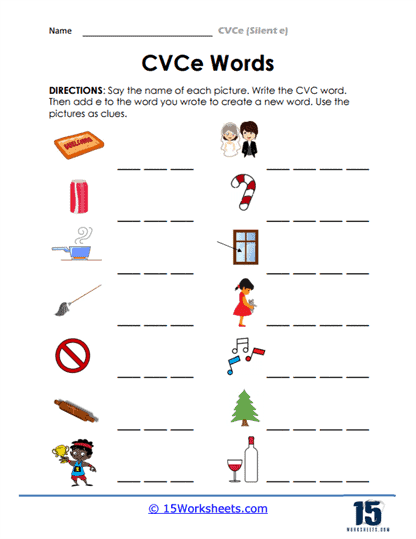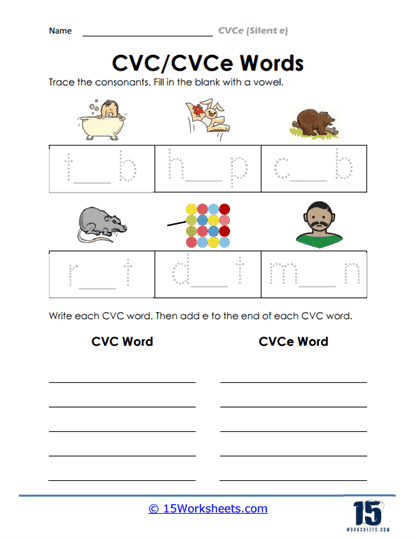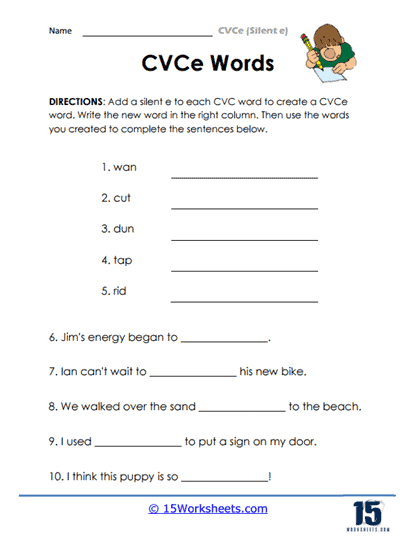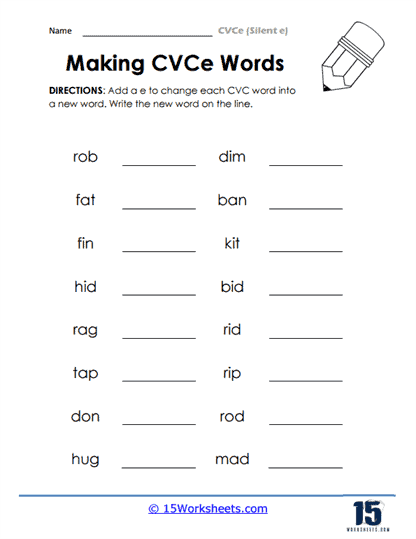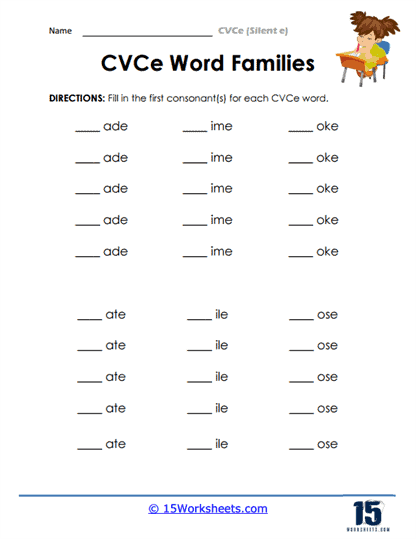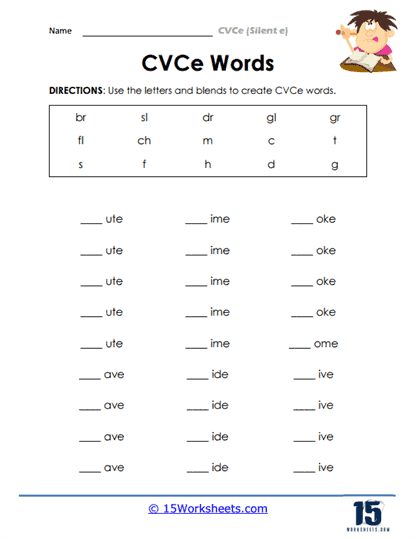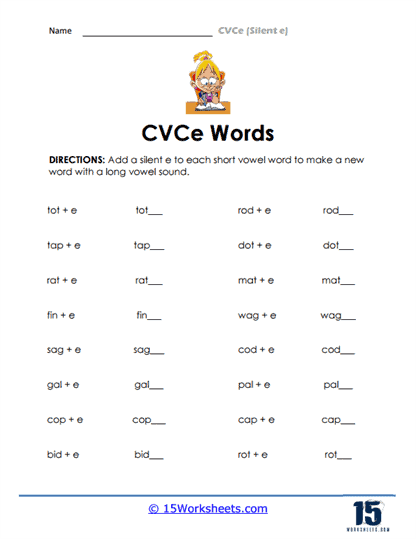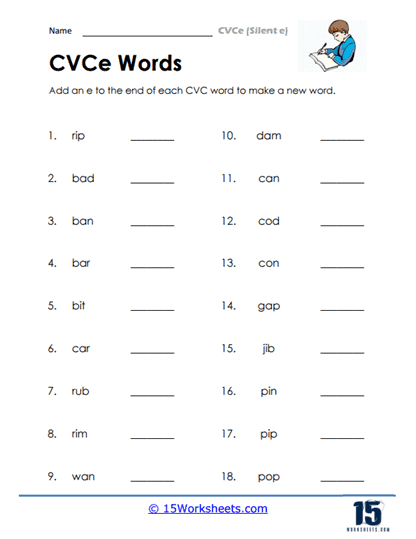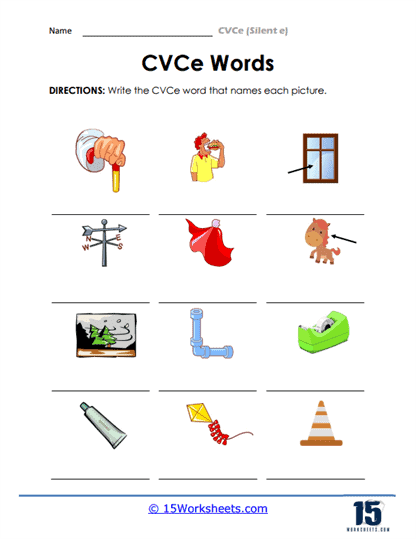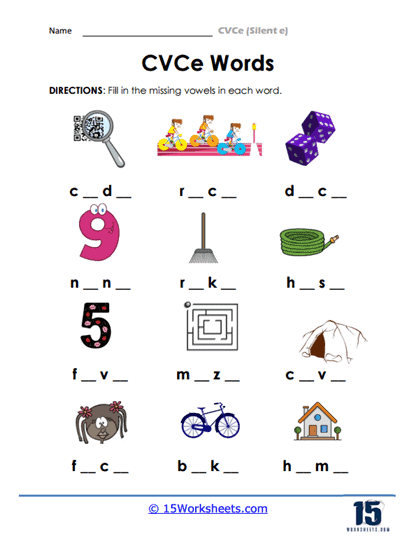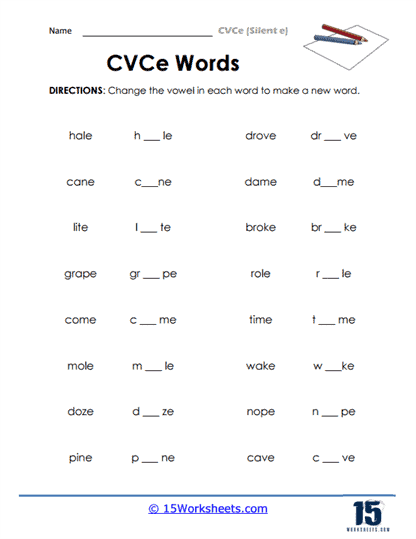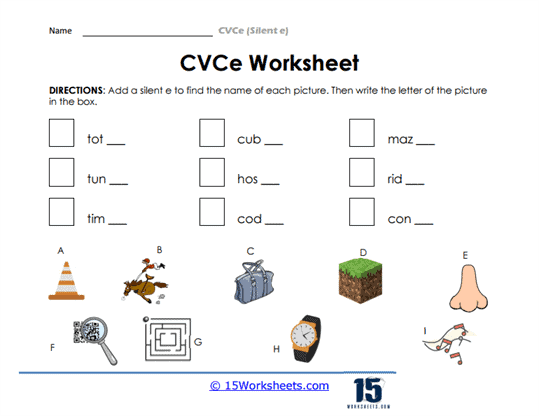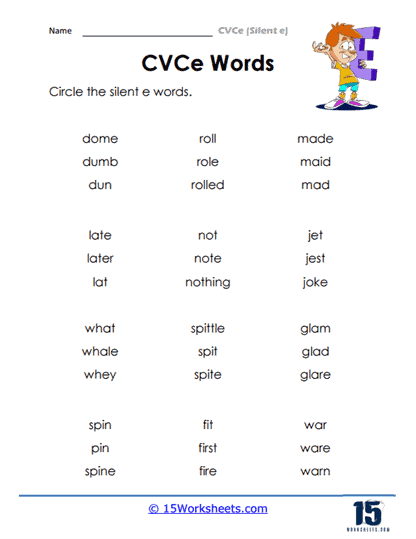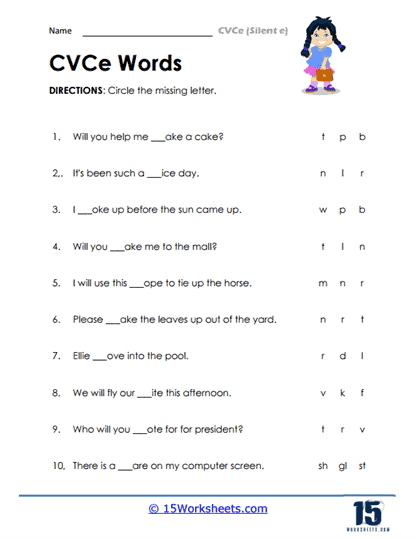CVCe (Silent e) Worksheets
About These 15 Worksheets
These CVCe (Silent e) worksheets will help learners understand and apply the concept of the silent “e” in English phonics. In a CVCe word, the silent “e” at the end of a word changes the pronunciation of the vowel that precedes it. For example, in the word “cap,” the vowel “a” has a short sound, but when an “e” is added to form the word “cape,” the “a” takes on a long sound, and the “e” remains silent. These worksheets are often used in early elementary education to build foundational reading skills, as they introduce children to the patterns of how adding a silent “e” can alter the way a word is pronounced.
These worksheets are particularly helpful for students as they improve reading fluency and decoding abilities. By repeatedly engaging with CVCe words, students can begin to recognize patterns in word structure, helping them not only read more efficiently but also understand spelling rules. CVCe worksheets also aid in vocabulary development, as they introduce learners to a wide variety of words that follow the silent “e” rule. This practice can lead to better comprehension and improved spelling accuracy. Ultimately, CVCe worksheets serve as stepping stones in transitioning from reading simple three-letter words (CVC) to more complex words, enhancing overall language arts proficiency.
The types of exercises commonly found on CVCe worksheets include word identification, matching, and spelling practice. For example, one common activity might ask students to look at a series of CVC words like “kit,” “hat,” or “hop” and add an “e” at the end to create new words— “kite,” “hate,” or “hope.” This exercise reinforces how the silent “e” changes the vowel sound from short to long. Another typical worksheet exercise might include word sorting, where students are asked to group words based on whether they have short vowel sounds (CVC words) or long vowel sounds (CVCe words). Such activities help solidify the concept of vowel sounds and patterns in spelling.
We begin with the shape-shifters of the English language-worksheets like Word Conversion Exercise, Complete and Transform, Short to Long, and Just Add the ‘E’. These sheets focus on the literal transformation of words, challenging students to see the difference one silent letter can make. They don’t just teach the rule; they put kids in the driver’s seat of the word factory, giving them the thrill of turning “mad” into “made” like some kind of vowel magician. It’s the kind of linguistic alchemy that would make even Merlin jealous.
From there, we move into context and application, where words stretch their legs and take on new meaning. In Use It In A Sentence and Silent ‘e’ Superpowers, students aren’t just learning what words become-they’re using them to build real sentences. These worksheets blend creativity with comprehension, inviting young writers to play with language like a new toy. After all, what’s more powerful than a silent “e”? Maybe a kid who knows how to use one.
Of course, for the visual learners, there’s a whole suite of engaging activities. Name That Image, Visual Clues, and Vowel Wordplay bring in pictures to help reinforce sound-symbol relationships. These sheets add a layer of intuitive understanding-pairing words with images in a way that clicks. Students don’t just decode words; they see them, imagine them, and connect them to the real world. It’s like phonics with a passport-sight, sound, and sense all traveling together.
And what’s a learning adventure without a little mystery? Adding and Matching, Eagle Eye Challenge, Cracking the Code, and CVCe Puzzlers bring the thrill of the hunt into phonics practice. These puzzle-style worksheets challenge students to pair, decipher, match, and decode-all while reinforcing that ever-important silent “e” concept. If Sherlock Holmes had a favorite phonics rule, you can bet this would be it.
Rounding out the collection are the builders-the foundational thinkers who like to tinker. The First Consonants and Word Constructor take students back to the basics of how words are formed. They explore how sounds combine, how letters lead, and how structure matters. These worksheets are where the groundwork is laid, giving students the confidence and clarity to understand why the silent “e” matters so much-and how to use it like a pro.
In addition to word manipulation activities, CVCe worksheets often feature reading comprehension and sentence-building exercises. Students might be asked to complete sentences by choosing the correct CVCe word, such as selecting “home” over “hop” or “hole” to complete the sentence, “The dog ran into the ____.” These types of exercises integrate vocabulary knowledge with contextual understanding, helping learners use CVCe words in real-world scenarios. Spelling tests, fill-in-the-blank exercises, and reading practice passages can also be included to offer a range of difficulty levels, ensuring learners get plenty of practice.
What Are CVCe Words?
CVCe words, often referred to as “silent e” or “magic e” words, are a foundational concept in early literacy education. These are four-letter words that follow a specific pattern: a consonant (C), followed by a vowel (V), another consonant (C), and then an “e” at the end, which is silent. The magic of the silent “e” lies in its ability to alter the sound of the vowel that comes before it. Typically, the silent “e” transforms a short vowel sound into a long vowel sound. For instance, in the word “cap,” the vowel “a” makes a short sound (as in /æ/). However, when we add the silent “e” to create “cape,” the vowel “a” shifts to a long sound, changing the pronunciation entirely.
Consider the word “bake.” Without the silent “e,” it would be pronounced as “bak,” with a short “a” sound. However, the final “e” changes the short “a” to a long “a,” making the word “bake” rhyme with “cake.” This pattern is consistent across many CVCe words, making it an essential building block in teaching phonics to young readers. Other common examples include words like “home,” where the “o” changes from a short vowel sound to a long “o,” and “cute,” where the silent “e” turns a short “u” into a long one. By recognizing this pattern, children unlock the ability to decode many words that they encounter in texts.
CVCe words are crucial for teaching children the relationship between letters and sounds, which is the essence of phonics. When children begin learning to read, they typically start with CVC (consonant-vowel-consonant) words like “cat,” “dog,” or “pen.” These words are simple and have short vowel sounds. As they progress, children are introduced to more complex words that follow the CVCe pattern. By learning that a silent “e” at the end of a word signals a change in the vowel sound, children gain an important tool for decoding more words independently.
For example, when a child encounters the word “ride,” they might initially read it as “rid” because they are used to decoding CVC words. However, when they apply their knowledge of the CVCe rule, they understand that the silent “e” lengthens the vowel “i,” changing the pronunciation to “ride.” This simple change can be a powerful moment of discovery for young learners, as they realize how letters interact to form different sounds. It not only builds their reading fluency but also boosts their confidence as they successfully decode words they may not have seen before.
Helping with Spelling
In addition to improving reading skills, silent e words play a significant role in developing spelling proficiency. Children who understand the CVCe pattern are better equipped to spell words accurately. For instance, if a child knows the word “hat” and learns that adding a silent “e” changes it to “hate,” they can apply this knowledge when spelling other similar words. This understanding is particularly useful because English spelling can often be tricky, and recognizing patterns like CVCe helps simplify the process.
By mastering silent e words, children also learn about homophones, or words that sound the same but have different meanings and spellings. For instance, the words “plane” and “plain” are pronounced identically but have different spellings and meanings. The silent “e” in “plane” is the key that differentiates it from “plain.” This knowledge not only helps children spell words correctly but also enhances their understanding of vocabulary and word meanings.
Enhancing Vocabulary
Another important benefit of learning CVCe words is the expansion of a child’s vocabulary. Many common English words follow the CVCe pattern, and as children become familiar with these words, they increase the range of words they can read and use. For instance, understanding words like “bake,” “ride,” “note,” and “hope” gives children access to a greater variety of words they will encounter in everyday reading materials.
By mastering CVCe words, children also learn about word families. Word families are groups of words that share the same root but have different beginnings or endings. For example, once a child knows the word “cake,” they can easily learn related words such as “bake,” “rake,” and “lake.” These word families help children recognize patterns in language, making it easier for them to decode new words and understand their meanings.
Reading Comprehension
Fluency in recognizing CVCe words also has a direct impact on reading comprehension. When children can quickly and accurately decode words, they spend less mental energy on sounding out individual letters and more on understanding the meaning of the text. Imagine a child reading the sentence, “The kite flew high in the sky.” If the child understands the silent e pattern in “kite,” they can read the word smoothly without stumbling, allowing them to focus on the overall meaning of the sentence. This fluency is critical for comprehension, as it frees up cognitive resources for thinking about what is being read rather than getting stuck on decoding every word.
CVCe words are common in a wide range of reading materials, from storybooks to school textbooks. By mastering these words, children gain the skills they need to tackle more advanced reading material, improving their overall literacy and comprehension skills.
Building a Strong Literacy Foundation
The importance of silent e words in early literacy cannot be overstated. These words serve as a bridge between simple, short-vowel CVC words and more complex words with varied vowel sounds. Learning silent e words gives children a strong foundation in phonics, which is essential for reading success. As they encounter more CVCe words in their reading, children become more confident readers, able to decode and understand increasingly complex texts.
Educators often use a variety of strategies to teach CVCe words, including worksheets, word lists, and interactive activities. For example, worksheets that focus on adding a silent “e” to CVC words help reinforce the concept, while activities like word sorting or memory games make the learning process engaging and fun. These teaching tools allow children to practice reading, writing, and spelling CVCe words in a supportive environment.

